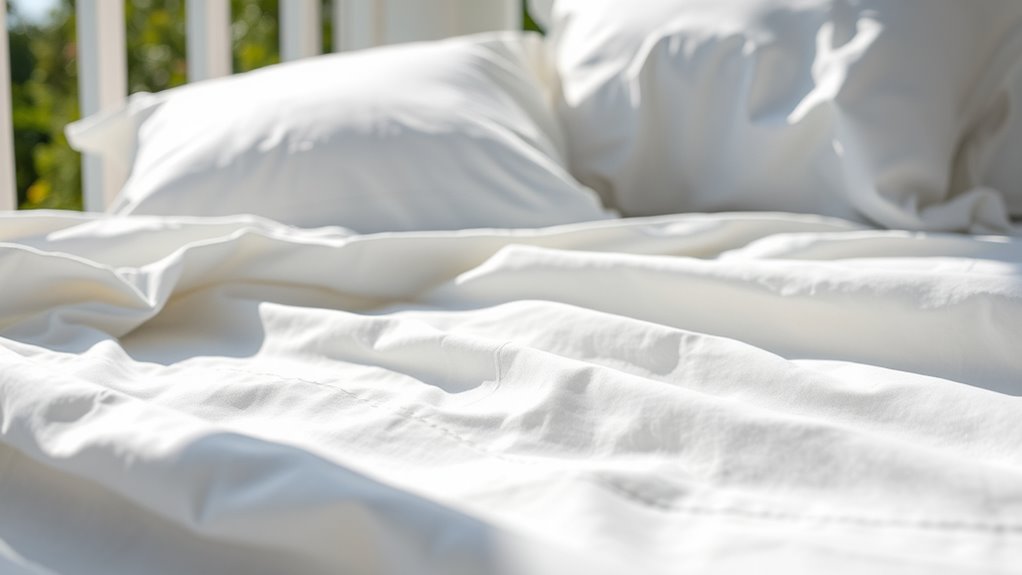Washing your bedding weekly is vital for preventing allergies and asthma symptoms. Regular cleaning removes dust mites, skin flakes, and other airborne particles that can trigger reactions. Using hot water of at least 130°F (54°C) kills dust mites and loosens dirt, ensuring better allergen removal. Consistent washing creates a cleaner, healthier sleep environment. Keep your bedding fresh and allergen-free—there’s more to discover if you continue exploring effective allergy prevention tips.
Key Takeaways
- Washing bedding weekly removes dust mites, skin flakes, and allergens, reducing allergy triggers and promoting a healthier sleep environment.
- Using hot water (at least 130°F/54°C) effectively kills dust mites and loosens embedded dirt and skin cells.
- Regularly drying bedding at high heat eliminates remaining dust mites and prevents allergen buildup.
- Complementary cleaning, such as vacuuming mattresses and washing pillowcases, enhances allergy prevention efforts.
- Consistent bedding hygiene alleviates allergy symptoms, improves breathing during sleep, and supports overall respiratory health.

Have you ever wondered how often you should wash your bedding? If you’re aiming to reduce allergy symptoms and create a cleaner sleeping environment, washing your sheets weekly is vital. Dust mites and skin flakes are two primary culprits that can trigger allergies, asthma, and skin irritation. These tiny creatures thrive in bedding because they feed on the dead skin cells you shed every day. Over time, dust mites can multiply rapidly, coating your mattress, pillowcases, and sheets. Their waste products and shed bodies become airborne particles, which you breathe in during sleep. Washing your bedding weekly helps keep these allergens at bay, ensuring you wake up feeling refreshed rather than congested or itchy.
When you wash your bedding regularly, you’re removing the buildup of skin flakes and dust mite waste, which are the main sources of allergic reactions. Skin flakes are tiny, lightweight particles that easily settle into your sheets and pillowcases. Over a week, these flakes accumulate, providing a food source for dust mites to reproduce and thrive. Without frequent washing, these allergens become more concentrated, increasing your exposure and the likelihood of allergy symptoms. By sticking to a weekly routine, you prevent the buildup of these particles, making your sleeping environment markedly less hospitable for dust mites. This not only improves your breathing but also reduces skin irritations and allergic reactions.
Using hot water, ideally at least 130°F (54°C), is essential when washing your bedding. Hot water kills dust mites and loosens dirt and skin flakes embedded in fabrics. If hot water isn’t an option, consider adding a specialized allergen spray or using a high-efficiency detergent designed to break down allergens. Drying your bedding thoroughly at high heat further helps eliminate dust mites, as they cannot survive in dry conditions. Regularly washing pillowcases, sheets, and duvet covers prevents the buildup of allergens and maintains a healthier sleep environment. Remember, your mattress should be vacuumed and aired out weekly too, but washing your bedding is the most effective way to remove the immediate sources of dust mites and skin flakes.
Frequently Asked Questions
Can Washing Bedding Too Often Cause Skin Irritation?
Washing your bedding too often can cause skin irritation because frequent washing may strip away natural oils, leaving your skin dry and sensitive. If your washing frequency is too high, especially with harsh detergents, you might notice redness or itchiness. To avoid this, find a balance that keeps your bedding clean without overdoing it. Using gentle detergents and lukewarm water can help prevent skin irritation while maintaining hygiene.
What’s the Best Detergent for Allergy-Sensitive Bedding?
Your best bet is to choose a hypoallergenic detergent that’s fragrance-free, ensuring you don’t introduce irritants to your allergy-sensitive bedding. These detergents are designed to remove allergens effectively without overwhelming your skin or senses. Look for options labeled specifically for sensitive skin, and avoid fragrances or dyes. This simple choice can make a world of difference, transforming your sleep environment into a sanctuary of comfort and allergy relief.
Do Different Bedding Materials Require Different Washing Methods?
Yes, different bedding materials require varying washing methods to maintain fabric durability and guarantee proper hygiene. For example, cotton can handle higher temperatures and more frequent washes, while delicate fabrics like silk need gentle cycles and cooler water. You should adjust your washing frequency based on the material’s durability and your allergy prevention needs. Always follow care labels to avoid damage and keep your bedding fresh and allergen-free.
How Do I Remove Stubborn Dust Mites From Bedding?
To remove stubborn dust mites from your bedding, focus on dust mite eradication through effective bedding treatment methods. Wash your bedding in hot water at least 130°F (54°C), which kills mites and their eggs. Use allergen-proof covers and consider freezing non-washable items for 24 hours. Regular vacuuming of your mattress and pillows also helps. Combining these methods guarantees thorough dust mite eradication, reducing allergy symptoms markedly.
Is It Necessary to Wash Pillows and Comforters Weekly?
Think of your pillows and comforters as the frontline soldiers in your sleep hygiene. You should wash pillows weekly to maintain good pillow hygiene, preventing dust mites and allergens from building up. Comforter maintenance is also essential; washing them every one to two weeks keeps your bedding fresh and allergen-free. Regular washing helps reduce allergens, ensuring a healthier, more restful sleep environment for you.
Conclusion
Washing your bedding weekly is a simple yet effective way to reduce allergens and improve your sleep quality. By keeping your sheets fresh, you create a healthier environment free from dust mites and other irritants. Isn’t your comfort worth the small effort it takes? Prioritize this routine, and you’ll wake up feeling more refreshed and allergy-free. After all, your health is worth every wash—so why not start tonight?









